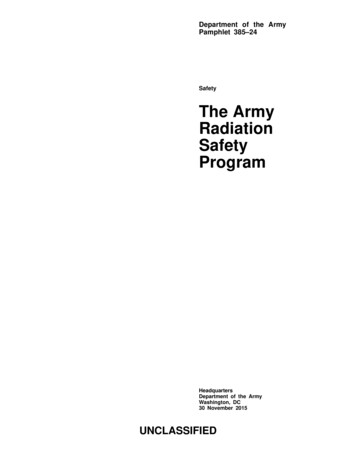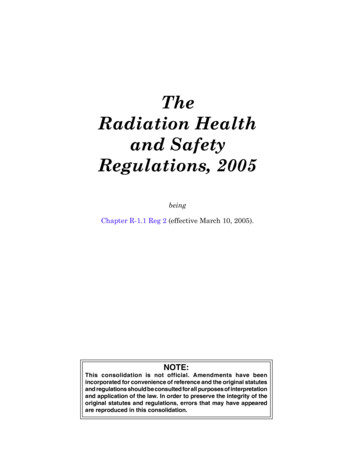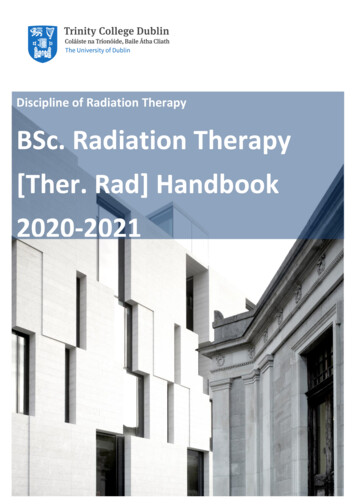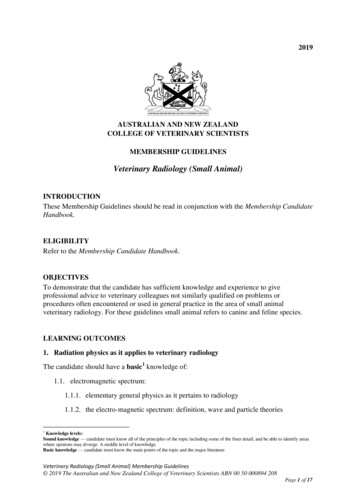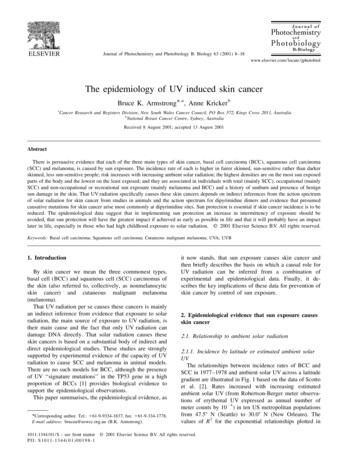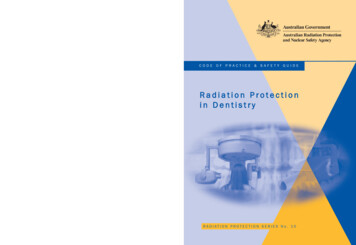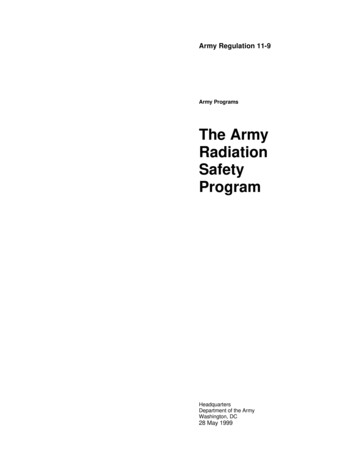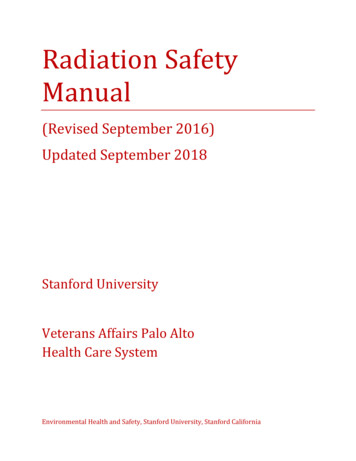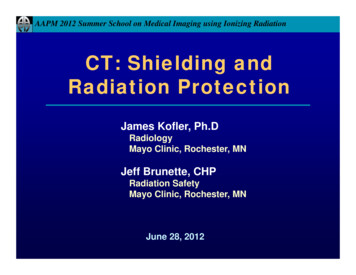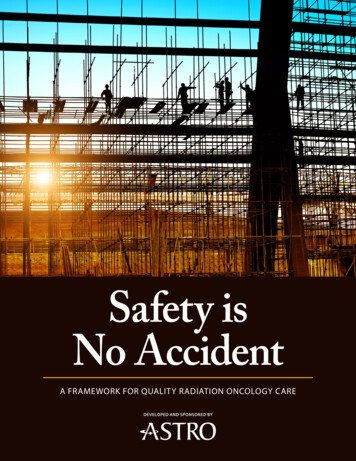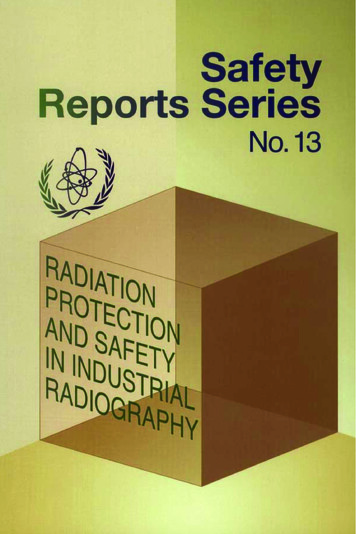
Transcription
RADIATION PROTECTIONAND SAFETYIN INDUSTRIAL RADIOGRAPHY
The following States are Members of the International Atomic Energy A ANDHERZEGOVINABRAZILBULGARIABURKINA FASOCAMBODIACAMEROONCANADACHILECHINACOLOMBIACOSTA RICACOTE D’IVOIRECROATIACUBACYPRUSCZECH REPUBLICDEMOCRATIC REPUBLICOF THE CONGODENMARKDOMINICAN REPUBLICECUADOREGYPTEL RMANYGHANAGREECEGUATEMALAHAITIHOLY SEEHUNGARYICELANDINDIAINDONESIAIRAN, ISLAMIC REPUBLIC ANKENYAKOREA, REPUBLIC OFKUWAITLATVIALEBANONLIBERIALIBYAN ARAB ARMALAYSIAMALIMALTAMARSHALL NAMIBIANETHERLANDSNEW RAGUAYPERUPHILIPPINESPOLANDPORTUGALQATARREPUBLIC OF MOLDOVAROMANIARUSSIAN FEDERATIONSAUDI ARABIASENEGALSIERRA LEONESINGAPORESLOVAKIASLOVENIASOUTH AFRICASPAINSRI LANKASUDANSWEDENSWITZERLANDSYRIAN ARAB REPUBLICTHAILANDTHE FORMER YUGOSLAVREPUBLIC OF MACEDONIATUNISIATURKEYUGANDAUKRAINEUNITED ARAB EMIRATESUNITED KINGDOM OFGREAT BRITAIN ANDNORTHERN IRELANDUNITED REPUBLICOF TANZANIAUNITED STATESOF AMERICAURUGUAYUZBEKISTANVENEZUELAVIET NAMYEMENYUGOSLAVIAZAMBIAZIMBABWEThe Agency’s Statute was approved on 23 October 1956 by the Conference on the Statute of theIAEA held at United Nations Headquarters, New York; it entered into force on 29 July 1957. TheHeadquarters of the Agency are situated in Vienna. Its principal objective is “to accelerate and enlarge thecontribution of atomic energy to peace, health and prosperity throughout the world’’. IAEA, 1999Permission to reproduce or translate the information contained in this publication may beobtained by writing to the International Atomic Energy Agency, Wagramer Strasse 5, P.O. Box 100,A-1400 Vienna, Austria.Printed by the IAEA in AustriaJanuary 1999STI/PUB/1066
SAFETY REPORTS SERIES No. 13RADIATION PROTECTIONAND SAFETYIN INDUSTRIAL RADIOGRAPHYINTERNATIONAL ATOMIC ENERGY AGENCYVIENNA, 1999
VIC Library Cataloguing in Publication DataRadiation protection and safety in industrial radiography.— Vienna :International Atomic Energy Energy, 1999.p. ; 24 cm. — (Safety reports series, ISSN 1020–6450; no. 13)STI/PUB/1066ISBN 92–0–100399–4Includes bibliographical references.1. Radiography, Industrial—Safety measures.Energy Agency. II. Series.VICLI. International Atomic99–00214
FOREWORDThe use of ionizing radiation, particularly in medicine and industry, is growingthroughout the world, with further expansion likely as technical developments resultfrom research. One of the longest established applications of ionizing radiation isindustrial radiography, which uses both X radiation and gamma radiation toinvestigate the integrity of equipment and structures. Industrial radiography iswidespread in almost all Member States. It is indispensable to the quality assurancerequired in modern engineering practice and features in the work of multinationalcompanies and small businesses alike.Industrial radiography is extremely versatile. The equipment required isrelatively inexpensive and simple to operate. It may be highly portable and capable ofbeing operated by a single worker in a wide range of different conditions, such as atremote construction sites, offshore locations and cross-country pipelines as well as incomplex fabrication facilities. The associated hazards demand that safe workingpractices be developed in order to minimize the potential exposure of radiographersand any other persons who may be in the vicinity of the work. The use of shieldedenclosures (fixed facilities), with effective safety devices, significantly reduces anyradiation exposures arising from the work.The demands and rewards of industrial radiography, the ready availability of theessential equipment, the wide range of working conditions and the fact that thetechniques employed usually involve the routine manipulation and exposure ofpowerful gamma emitting sources and X ray machines have all been identified ascontributory to the likelihood of accidents. Even in Member States with highlydeveloped regulatory infrastructures, industrial radiographers, on average, receiveradiation doses that exceed those of other occupationally exposed workers, andindividual industrial radiographers are the most likely group of workers to receivedoses approaching relevant dose limits. Radiation protection and safety in industrialradiography is thus of great importance in both developed and developing countries.This Safety Report summarizes good and current state of the art practices inindustrial radiography and provides technical advice on radiation protection andsafety. It contains information for Regulatory Authorities, operating organizations,workers, equipment manufacturers and client organizations, with the intention ofexplaining their responsibilities and means to enhance radiation protection and safetyin industrial radiography.
EDITORIAL NOTEAlthough great care has been taken to maintain the accuracy of information containedin this publication, neither the IAEA nor its Member States assume any responsibility forconsequences which may arise from its use.The use of particular designations of countries or territories does not imply anyjudgement by the publisher, the IAEA, as to the legal status of such countries or territories, oftheir authorities and institutions or of the delimitation of their boundaries.The mention of names of specific companies or products (whether or not indicated asregistered) does not imply any intention to infringe proprietary rights, nor should it beconstrued as an endorsement or recommendation on the part of the IAEA.
CONTENTS1.INTRODUCTION . . . . . . . . . . . . . . . . . . . . . . . . . . . . . . . . . . . . . . . . .11.1.1.2.1.3.1.4.Background . . . . . . . . . . . . . . . . . . . . . . . . . . . . . . . . . . . . . . . . . .Objective . . . . . . . . . . . . . . . . . . . . . . . . . . . . . . . . . . . . . . . . . . . .Scope . . . . . . . . . . . . . . . . . . . . . . . . . . . . . . . . . . . . . . . . . . . . . .Structure . . . . . . . . . . . . . . . . . . . . . . . . . . . . . . . . . . . . . . . . . . . .11222.OBJECTIVES OF RADIATION PROTECTION AND SAFETY . . . . . .23.ORGANIZATIONAL RESPONSIBILITIES . . . . . . . . . . . . . . . . . . . . .43.1.3.2.3.3.3.4.3.5.4.5.6.Regulatory Authority . . . . . . . . . . . . . . . . . . . . . . . . . . . . . . . . . . .The operating organization . . . . . . . . . . . . . . . . . . . . . . . . . . . . . .Industrial radiographer/worker . . . . . . . . . . . . . . . . . . . . . . . . . . .The manufacturers and suppliers . . . . . . . . . . . . . . . . . . . . . . . . . .The client . . . . . . . . . . . . . . . . . . . . . . . . . . . . . . . . . . . . . . . . . . .49161719TYPES OF EXPOSURE DEVICES . . . . . . . . . . . . . . . . . . . . . . . . . . . .204.1.4.2.4.3.4.4.4.5.4.6.4.7.Gamma radiography sources and containers . . . . . . . . . . . . . . . . .X ray radiography equipment . . . . . . . . . . . . . . . . . . . . . . . . . . . .Accelerators . . . . . . . . . . . . . . . . . . . . . . . . . . . . . . . . . . . . . . . . .Underwater radiography equipment . . . . . . . . . . . . . . . . . . . . . . . .Pipe crawler equipment . . . . . . . . . . . . . . . . . . . . . . . . . . . . . . . . .Real time radiography . . . . . . . . . . . . . . . . . . . . . . . . . . . . . . . . . .Neutron radiography . . . . . . . . . . . . . . . . . . . . . . . . . . . . . . . . . . .20272929303132DESIGN AND USE OF SHIELDED ENCLOSURES(FIXED FACILITIES) . . . . . . . . . . . . . . . . . . . . . . . . . . . . . . . . . . . . . .335.1.5.2.5.3.5.4.Enclosure design and use . . . . . . . . . . . . . . . . . . . . . . . . . . . . . . .Shielding design for a shielded enclosure . . . . . . . . . . . . . . . . . . .Control of exposure in shielded enclosures . . . . . . . . . . . . . . . . . .Operating procedures for shielded enclosures . . . . . . . . . . . . . . . .33343637SITE RADIOGRAPHY PROCEDURES . . . . . . . . . . . . . . . . . . . . . . . .386.1. Boundary of controlled area . . . . . . . . . . . . . . . . . . . . . . . . . . . . .38
6.2.6.3.6.4.6.5.6.6.Shielding . . . . . . . . . . . . . . . . . . . . . . . . . . . . . . . . . . . . . . . . . . . .Administrative arrangements . . . . . . . . . . . . . . . . . . . . . . . . . . . . .Monitoring . . . . . . . . . . . . . . . . . . . . . . . . . . . . . . . . . . . . . . . . . .Additional precautions for gamma radiography . . . . . . . . . . . . . . .Additional precautions for X radiography including use ofaccelerators . . . . . . . . . . . . . . . . . . . . . . . . . . . . . . . . . . . . . . . . . .6.7. Additional precautions for underwater radiography . . . . . . . . . . . .6.8. Additional precautions for pipeline crawlers . . . . . . . . . . . . . . . . .434445STORAGE, MOVEMENT AND TRANSPORT OF RADIOGRAPHICSOURCES AND EXPOSURE DEVICES . . . . . . . . . . . . . . . . . . . . . . .467.1. Storage of sources . . . . . . . . . . . . . . . . . . . . . . . . . . . . . . . . . . . . .7.2. Movement and transport of sources . . . . . . . . . . . . . . . . . . . . . . . .4646EMERGENCY RESPONSE PLANNING . . . . . . . . . . . . . . . . . . . . . . .478.1.8.2.8.3.8.4.Emergencies resulting in exposures . . . . . . . . . . . . . . . . . . . . . . . .Emergency planning and preparedness . . . . . . . . . . . . . . . . . . . . .Specific emergency procedures . . . . . . . . . . . . . . . . . . . . . . . . . . .Accident notification and report . . . . . . . . . . . . . . . . . . . . . . . . . .48485255REFERENCES.GLOSSARY.CONTRIBUTORS TO DRAFTING AND REVIEW . . . . . . . . . . . . . . . . . . . .5759617.8.40404142
1. INTRODUCTION1.1. BACKGROUNDRadiography is of vital importance in non-destructive testing. Radiographyensures the integrity of equipment and structures such as vessels, pipes, welded joints,castings and other devices. The integrity of this equipment affects not only the safetyand quality of the products used by workers, but also the safety and quality of theenvironment for workers and the public at large.The safety record of over 40 years of application of ionizing radiation is verygood. In particular, radiography can be performed so as to pose a negligible risk onthe public and with sufficiently low occupational radiation exposure so as to pose noundue radiological risk on the workers.However, experience has also shown examples of bad practice. Radiographyproduces high dose rates so that a person accidentally exposed to the primary beamor in close contact with an unshielded source might within minutes or even secondsreceive a dose that results in injury. Also, contamination can result from corroded ordamaged sources. Working under adverse conditions might result in operationalsituations in which the principle of keeping doses as low as reasonably achievable iscompromised or not met. These aspects indicate the need to achieve a high degree ofprofessionalism in radiography, using sources and devices designed to the higheststandards and working in an environment that promotes a safety culture. This can beaccomplished by means of an appropriate national and organizational infrastructure,effective training of workers, compliance with safety requirements, and effectivequality control, together with good design, manufacture and maintenance of sourcesand devices.1.2. OBJECTIVEThis Safety Report discusses good and current state of the art practices for thesafe control and operation of radiography equipment and facilities. It is recognizedthat this equipment may be used in countries with little or no experience in its use orwithout a well developed programme of radiation protection.The purpose is to provide information on safe practices to persons intending touse radiographic techniques and equipment and to governments and their RegulatoryAuthorities responsible for regulating such use.1
1.3. SCOPEThis Safety Report relates to all types of industrial radiography equipment andfacilities. It is only concerned with radiation protection and safety and does not dealwith how to use radiographic techniques for non-destructive testing.1.4. STRUCTURERadiation protection and safety objectives and considerations are presented inSection 2, while Section 3 describes typical organizational responsibilities forradiation protection and safety in industrial radiography. Sections 4, 5 and 6 deal withtypes of exposure devices, design and use of shielded enclosures and site radiography,respectively. In Section 7, radiation safety in storage and transport of radiographicsources is discussed, while Section 8 covers emergency response planning inindustrial operations.2. OBJECTIVES OF RADIATION PROTECTIONAND SAFETYThe primary aim of radiation protection and safety is to provide appropriatestandards of protection and safety for people without unduly limiting the benefits ofpractices giving rise to exposure.This primary aim is expressed by the following objectives of radiationprotection and safety [1]:“Protection objectives: to prevent the occurrence of deterministic effects inindividuals by keeping doses below the relevant threshold and to ensure that allreasonable steps are taken to reduce the occurrence of stochastic effects in thepopulation at present and in the future.”“Safety objectives: to protect individuals, society and the environment fromharm by establishing and maintaining effective defences against radiological hazardsfrom sources.”Industrial radiography sources emit X rays and gamma radiation which producedose rates of the order of hundreds of milligrays per hour at one metre. These highdose rates at close distances can cause severe injuries such as radiation burnsfollowing exposures of a few seconds. Workers using such sources must achieve theprotection objective to prevent doses arising from acute and chronic accidental2
exposures and unsafe work practices likely to cause injuries to develop. Safe workpractices will protect not only the individual worker but also others in the vicinity andthe public from serious consequences arising from the loss or uncontrolled use ofthese sources.These radiation protection and safety objectives apply to the design,manufacture or construction, commissioning, operation, maintenance anddecommissioning of exposure devices, sealed sources and fixed facilities forindustrial radiography. They also apply to the development, application and review ofall operating procedures.The Basic Safety Standards (BSS) are internationally harmonized safetystandards that establish requirements for the protection of health and theminimization of danger to life. The BSS establish basic requirements for protectionagainst the risks associated with exposure to ionizing radiation and for the safety ofradiation sources that may deliver such exposure, to be fulfilled in all activitiesinvolving radiation exposure. They indicate the different aspects that should becovered by an effective radiation protection programme [2]. The present publicationprovides information on methods that can be used to ensure radiation safety,specifically in industrial radiography.Adherence to the requirements of the BSS will:(a)(b)(c)Ensure that during normal operation, maintenance and decommissioning, andin emergency situations, the radiation exposure of both workers and the publicis kept as low as reasonably achievable, economic and social factors beingtaken into account (ALARA principle);Ensure that during normal operation, maintenance and decommissioning, andin emergency situations, the radiation exposure of both workers and the publicis kept below the relevant dose limits given in the BSS;Ensure that the probability of events giving rise to significant exposures and themagnitude of such exposures are kept as low as reasonably achievable,economic and social factors being taken into account.Several points or concepts need to be considered in radiation protection programmes:(a)The sources, exposure devices and facilities need to be of such a design thatfaultless operation is ensured as effectively as possible. The design includessufficient safety systems to prevent, detect and respond to deviations fromnormal operating conditions, considering good engineering practice andconcepts of redundancy, diversity, independence and quality assurance.This requires that exposure devices and facilities be routinely reviewed andinspected as part of a formal maintenance programme to ensure continued safeoperation. Quality assurance programmes are established to review and assess,3
(b)(c)(d)(e)(f)on a regular basis, the effectiveness of the overall radiation protectionprogramme and the implementation of the radiation safety requirements.A safety culture is fostered and maintained among all workers involved in theindustrial radiography industry, from the policy makers and managers ofoperating organizations to the radiographers. This is necessary to encourage apositive attitude towards protection and safety and to discourage complacency.Industrial radiography is performed in compliance with dose constraints.Workers have appropriate qualifications and training.There are available safe operational procedures for both routine, non-routineand accident situations.A means is provided for detecting incidents and accidents including those inwhich human errors were a contributory factor. Exchange of experience andfeedback from operational practice is important between all relevant partiesinvolved directly and indirectly in the safe performance of radiographictechniques especially between operators and manufacturers. An analysis of thecauses and lessons learned will reduce as far as reasonably practicable thecontribution of human error to future accidents and other events that could giverise to exposures. These considerations should be included in the design ofradiographic sources and devices, development and conduct of theoretical andpractical training programmes, emergency and survey equipment, and in thedevelopment of regulatory requirements and operating procedures. The IAEASafety Report on Accidents in Industrial Radiography and Lessons to beLearned reports previous accidents, the lessons learned from them and thepreventive actions [3].3. ORGANIZATIONAL RESPONSIBILITIESThe safe performance of industrial radiography relies on the people andorganizations involved meeting certain responsibilities. These organizations are theRegulatory Authority, the operating organization responsible for carrying out thework, the industrial radiographers, device manufacturers, qualified experts and theclient responsible for hiring the operating organization. It is necessary for allconcerned to co-operate.3.1. REGULATORY AUTHORITYA regulatory system is needed to authorize an application involving sources ofradiation to conduct radiography. The consequences of poor or non-existent4
regulatory control can be serious and may result in hazardous conditions which mayremain undetected for long periods of time.The general functions of the Regulatory Authority include the following: thedevelopment of radiography regulations and guidance; the assessment of applicationsfor permission to conduct radiography; the authorization of such practices and the useof radiation sources associated with them, subject to certain specified conditions; theconduct of periodic inspections to verify compliance with the conditions; and theenforcement of any necessary actions to ensure compliance with the regulations andstandards.3.1.1.Authorization processControl of practices involving exposure devices for industrial radiography isachieved by means of a system of registration or licensing. The system used willdepend on the legislation in place in any given country. The major stages of theauthorization process include control of the design, manufacture and distribution ofthe exposure devices, construction of facilities for industrial radiography, operatingprogramme and decommissioning.The Regulatory Authority has to assess applications for authorization toconduct the practices. In these cases, the format and content to be submitted by theapplicant in support of an authorization application are established by the RegulatoryAuthority.Before authorizing the operation of an exposure device or a shielded enclosure(fixed facility), the Regulatory Authority (or qualified expert as allowed by nationalrequirements) needs to complete the review and assessment of:(a)(b)(c)(d)(e)(f)(g)(h)the exposure device;the facility, as constructed;the results of any commissioning tests;the adequacy of operating and maintenance instructions and procedures and ofemergency arrangements;the records to be kept and the reports to be made both internally and to theRegulatory Authority;the training and qualifications of personnel and the arrangements for periodictraining and for ensuring that adequate standards of training are maintained;the quality assurance programme for equipment and procedures;the arrangements for periodic testing, maintenance, auditing and surveillance.It is also important to ensure at this stage that:(a)all safety features and warning devices operate correctly;5
(b)(c)there is sufficient radiation protection of all persons and the environment;the operating organization is adequately supplied with information on the correctoperation, maintenance and decommissioning of the exposure device and facilities.The Regulatory Authority gives authorization to the practices and prescribes theconditions or requirements to be attached to the authorization. These requirementsmay n of sources and devices, including activity or energy as applicable;dose constraints or dose rate limitations;appointment of radiation protection personnel and authorized users;periodic tests and surveys of radiation protection and safety aspects of theexposure devices and facilities;record keeping and regular reports to the Regulatory Authority on safetymatters such as:— operating practices,— radiological data, such as the results of radiation surveys, personaldosimetry and medical surveillance,— maintenance of exposure devices and fixed facilities,— unusual occurrences, such as significant malfunction of a safety system;modifications to shielded enclosures;changes in the operating procedures and in the emergency plan, which mayhave significant consequences for safety;notifications and reports to the Regulatory Authority on incidents with actual orpotential radiological consequences;places of use and storage; andarrangements for personnel dosimetry.When safety related changes are indicated in operational conditions or inequipment and procedures, the Regulatory Authority (or qualified expert as allowed)needs to review and assess the proposed changes before authorizing theirimplementation.Whenever the Regulatory Authority becomes aware of a breach ofrequirements, it may issue a notice to modify, suspend or revoke an operatingorganization’s authorization for work.Before authorizing the decommissioning of any exposure device or shieldedenclosure, the Regulatory Authority may require a review and assessment of theproposed procedures to ensure that radiation safety is maintained.Whenever the Regulatory Authority becomes aware of improvements in safetyrelated technologies it can modify the operating organization’s authorization for workpractices, equipment or facilities.6
3.1.2.Regulatory inspectionThe Regulatory Authority is responsible for ensuring the regulatory inspectionof the practices involving exposure devices, to determine whether the applicant isfulfilling the requirements and conditions set out in the pertinent regulations and/orin the authorization.Inspection programmes confirm that:(a)(b)(c)(d)(e)(f)(g)(h)(i)(j)shielded enclosures are constructed and exposure devices are manufactured incompliance with authorizations;all safety systems and components of shielded enclosures and exposure devicesare of the required quality;personnel are trained and competent to operate the exposure devices safely;approved operational procedures are being followed;exposure devices and shielded enclosures are appropriately surveyed andmaintained;sources are sealed and leak free;dosimetric and medical surveillance of the workers are carried out correctly;the response to incidents follows the agreed emergency plan or regulatoryrequirements;exposure devices and shielded enclosures are maintained in a safe and securecondition at the end of use or are decommissioned safely;the source inventory is properly maintained.In addition to routine regulatory inspection activities, the Regulatory Authorityneeds to ensure that inspection and immediate investigation of events and incidentsare carried out.Regulatory inspections are not meant to take away or limit the responsibility ofthe operating organization.3.1.3.EnforcementThe Regulatory Authority has powers to enforce compliance with the relevantregulations and authorizations, including the powers to take samples, makemeasurements and require an operating organization to modify or correct any aspectof a procedure, practice, system, structure or component as necessary to ensure safety.The Regulatory Authority has the power to require an operating organization to ceaseoperation, as necessary and reasonable, to ensure safety.The severity of the actions of the Regulatory Authority depends on the hazardsand risks caused by the deviations or violations. In many cases a written notice ordirective to the responsible organization may be sufficient. In the event of chronic or7
extremely serious deviations, activities may be curtailed through suspension orrevocation of the authorization.3.1.4.EmergencyThe responsibilities of the Regulatory Authority in the implementation ofemergency plans [2] vary according to the type of accident and national requirements.The primary responsibility resides with the operating organization. Simple incidentsmay be resolved by this organization and only require notification to the RegulatoryAuthority in routine reports or inspections, as defined by the Regulatory Authority.In view of the diversity of the events that might occur, the Regulatory Authorityneeds to draw up emergency plans which are general in nature and include thefollowing activities:— assessment and projection of off-site radiological consequences;— maintenance of close contact with the local emergency organizations;— assisting the operating organization in carrying out the emergency response;— identification of potential medical assistance.The Regulatory Authority or qualified expert may provide guidance to theoperating organization on how to prepare the emergency plan, which is a prerequisiteof any licensing or authorization procedure. As a minimum, emergency plans coverevents with the greatest potential for exposure as described in Section 8.1.Emergency notification by the operating organization is required by theRegulatory Authority. The Regulatory Authority has to be able to receive theemergency notification and to provide an adequate response to the emergency.The Regulatory Authority requires that, in the emergency response, radiologicalsurveys of areas be carried out as appropriate and doses be assessed.In the post-emergency phase, the Regulatory Authority requires a report ofinvestigation into the causes of the emergency, its consequences, including a fullassessment of the doses and corrective actions taken to prevent a recurrence. TheRegulatory Authority evaluates the extent to which the emergency plan wasimplemented and its effectiveness in order to determine whether the plan requiresmodification.Much can be learned from previous experience of emergency situations andtheir resolution. The Regulatory Authority may be in the best position to collateemergency case histories. These accounts are reviewed periodically so that futureaccidents may be prevented and informed responses are available to deal with futureemergencies. The publication of emergency case history reviews helps to alert theinternational community to specific problems and improved solutions developed fromexperience.8
3.2. THE OPERATING ORGANIZATIONThe operating organization responsible for possession and use of radiographysources and exposure devices has to obtain from the Regulatory Authority anyauthorizations necessary for their acquisition, storage and use, once the necessaryprerequisites are met. The operating organization is responsible for carrying outindustrial radiography in accordance with legislation and authorizations. Anycondition laid down in the authorization has to be complied with. The managementstructure will vary with the size and complexity of the organization. However, itestablishes clear lines of responsibility and accountability for the protection andsafety of the sources throughout their operational lifetime within an organization, upto safe disposal.The senior management of the operating organization needs to make acommitment to safety, to keeping doses as low as reasonably achievable (ALARA),and has to publicize this to all personnel. This will foster the appropriate safetyculture within the operating organization. Good safety performance is a factor thatmust be incorporated into the daily routine of performing radiography by allpersonnel so that the job can be performed properly. Safety performance should be afactor by which the performance of managers, supervisors and radiographers isjudged.The operating organization has to develop and implement a quality assuranceprogramme, which defines the responsibilities on all levels and which details therequirements of the organization, personnel and equipment. The quality assuran
doses approaching relevant dose limits. Radiation protection and safety in industrial radiography is thus of great importance in both developed and developing countries. This Safety Report summarizes good and current state of the art practices in industrial radiography and provides technical advice on radiation protection and safety.
